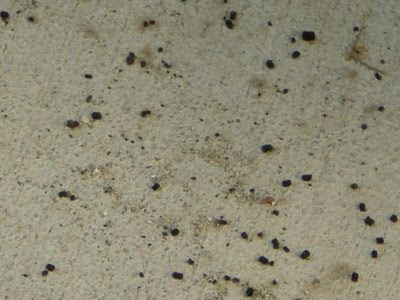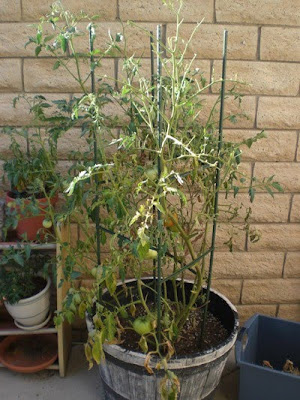
Tomato hornworms are the larvae of a large sphinx moth that is about the size of a hummingbird. In spring the moth lays eggs on the underside of tomato leaves, and the hornworm is quite small when it first emerges. However, they are big eaters (of tomato leaves) and grow up quickly. Usually, you won’t even discover this fellow until it is large–about 2 inches long and fat! They are quite distinctive, and some of the ugliest bugs that I have ever seen! If you are finding them at this time of the year, here is how you handle them. Prevention will follow below.
Don’t be afraid of the hornworms. They look more frightening than they are. They don’t bite or sting, just try to look big and ferocious.
Know the signs. Droppings on and around the plants are an indication that the beasts are near, as are chewed leaves and stalks.

You can easily handpick these beasts to remove them from your tomato plant then just throw them away. I generally wear gloves while doing this. You can also pay your kids to do this, come up with a bounty and offer it to the kids. .05 to .25 per worm depending on your children’s ages and your income bracket.
You must continue to be on the look out for them, they grow rapidly and eat a lot, so they can devastate a plant in a short amount of time.

There is also a different tactic that you can take with hornworm. While handpicking hornworm, look to see if you find little white cocoons attached to its back. If you find these, the cocoon is a pupating braconid wasp, which is a garden-friendly predator.
Capture the hornworm and keep any that have this cocoon in a container, feeding them tomato leaves. In this manner you will be incubating your own pest control! The cocoons will develop into the braconid wasps.
Release the wasps into your garden! These wasps will control the hornworm population.
Preventative Measures – When the hornworm are younger and smaller they can be killed using Bt (bacillus thuringiensis) as an effective management technique. This must be sprayed on the plant when you first plant it or BEFORE you find any big hornworms.

Tips & Warnings:
Other natural predators are birds and the larvae of the green lacewing, if your garden is bird friendly you will have a built in head start.
Plant Dill – the hornworms like it and they are easier to spot when they are smaller on the dill than on your tomato plants.
Be sure to rotate your crops, tomatoes/peppers/eggplants are in the same family & have the same pests, so put these crops where last year you had lettuce or peas. The larvae of the hornworm may stay in the soil and come back in droves the next year.
If you plant in pots, either rotate the crops or simply throw out the soil and start with fresh soil each year.
If you have a bee allergy in the family the wasp solution is NOT the best option for you and your family.







